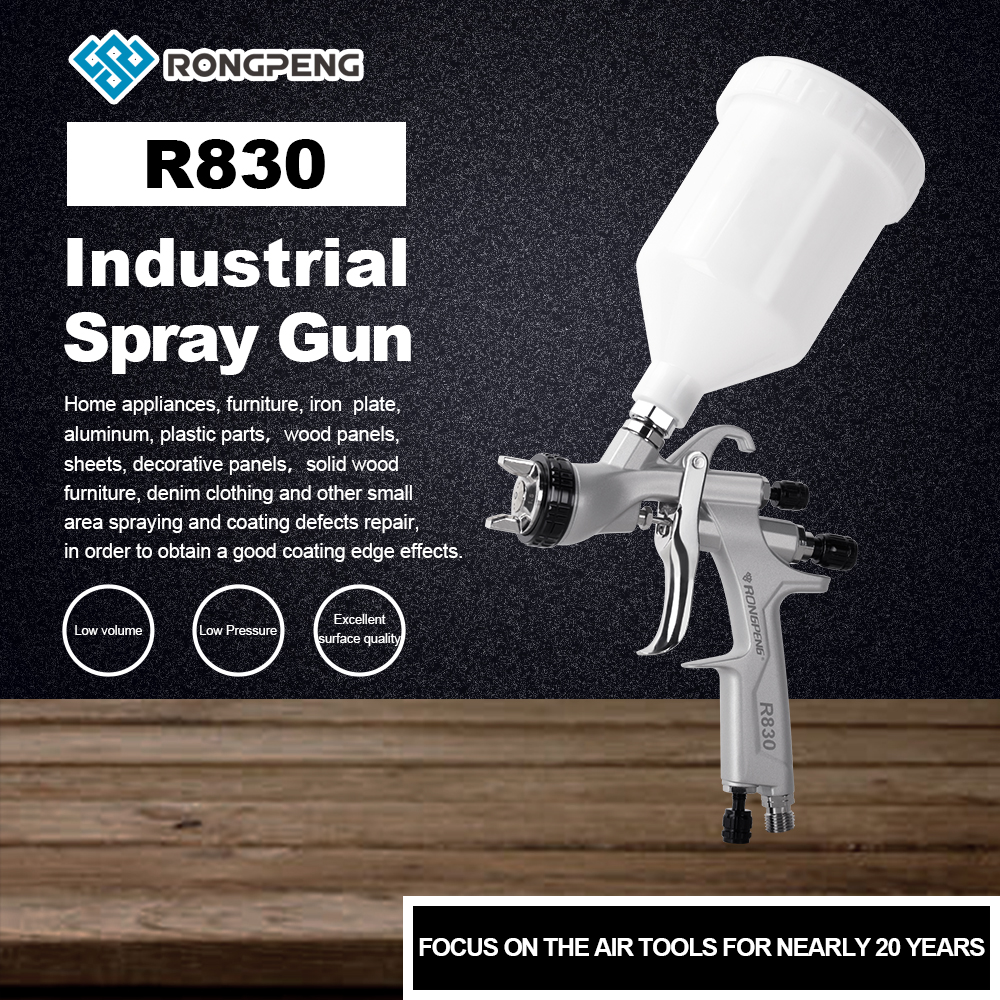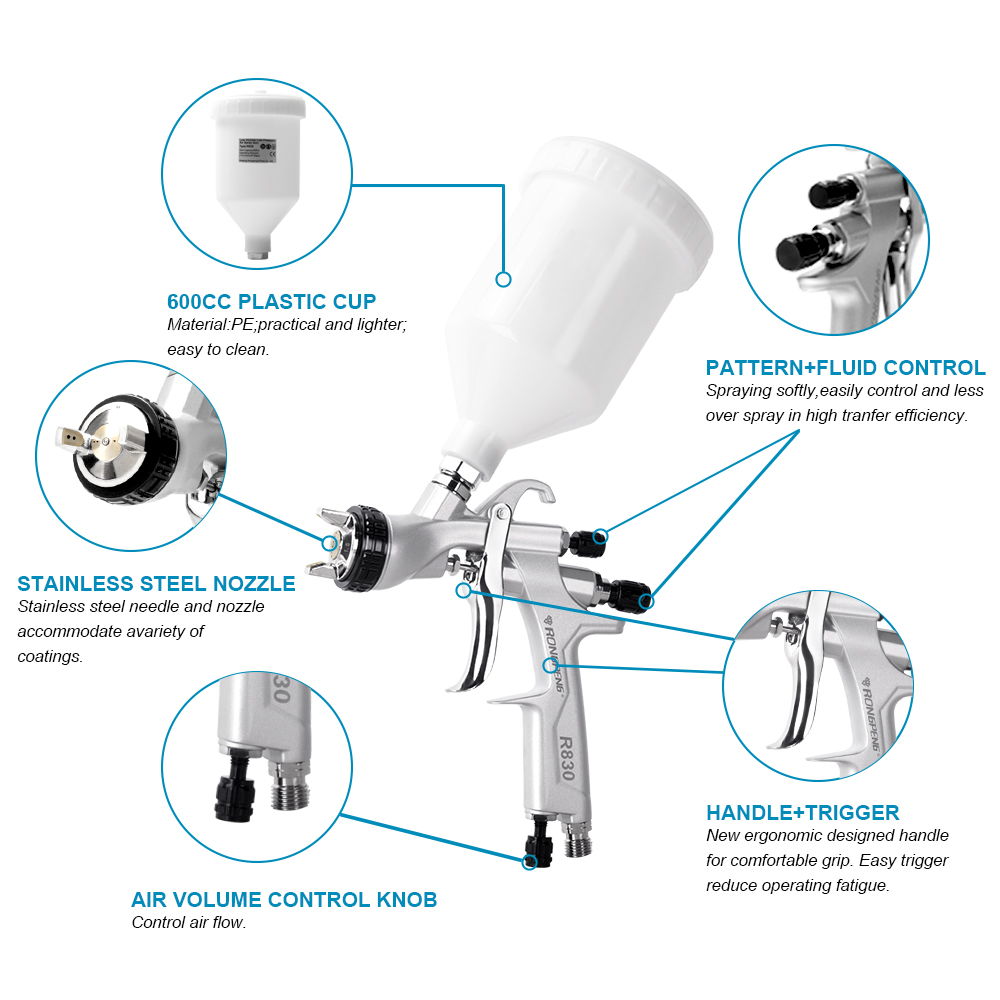

The key to LVLP's success lies in its ability to atomize the paint or coating material more effectively, even at lower pressures. There are a few key things may users don't know about properly using an LVLP spray gun to get professional-quality results.
Mastering Air Pressure and Fluid Delivery
At the core of LVLP spray gun operation is balancing the right air pressure and fluid delivery for the specific paint material and job at hand. Too little air pressure and the fan pattern will be inconsistent and dry. Too much pressure and you'll create excessive overspray and waste material.
However, pressure needs can vary based on the specific fluid viscosity, the spray gun's fluid nozzle size, and the desired fan pattern size. Start with the knob open just a few turns and increase it until you see the port holes are creating an even, cone-shaped fan pattern. Going too far can cause spitting and excessive paint flow.
Next, adjust the fan pattern control to achieve the desired spray pattern shape and width. A wider fan pattern is ideal for larger surface areas, while a narrower pattern may be better suited for intricate details or edges.
Dial in the air pressure to the recommended range for your specific LVLP spray gun model and the material you're spraying. Higher pressures will result in a more atomized spray pattern, while lower pressures may produce a wetter, less atomized finish.
Understand LVLP Spray Gun Limitations
While LVLP spray guns excel in many applications, they also have certain limitations compared to higher pressure conventional spray guns. Because LVLP guns operate at lower air pressures, they may struggle to fully atomize highly viscous or abrasive materials. Attempting to spray these types of coatings can lead to excessive overspray, an inconsistent spray pattern, or even clogging.
Additionally, LVLP guns typically have a slower coating application rate due to their lower fluid delivery. For large surface areas or rapid production, consider using a conventional spray gun or other application method to improve efficiency.
LVLP spray guns also tend to have a smaller spray pattern size compared to high-pressure guns. While beneficial for precision work, this can make covering expansive areas more time-consuming.
Finally, LVLP guns may not be the ideal choice for spraying highly textured or filled coatings like gelcoats or heavy-bodied primers. The lower pressure can prevent proper atomization and delivery of these heavily loaded materials.
Cleaning and Maintenance
One aspect of LVLP spraying that's often overlooked is diligent cleaning and maintenance of the spray gun after each use. Failing to properly clean the device can quickly clog the fluid nozzle, air cap, and passageways. This will create all sorts of spraying issues like spitting, heaving, and clogging in future uses.
The first step is using the appropriate solvent-based cleaner for the paint material you sprayed. This typically involves disassembling the gun, soaking the components in an appropriate solvent or cleaner, and thoroughly cleaning all passages and air channels.
Make sure to also brush out any dried paint buildup in the air cap and fluid nozzle with a horsehair brush. Compressed air can help dislodge any stubborn debris as well. Reapply a spray gun lubricant before reassembling too.
Don't overlook cleaning the air inlet filter regularly either. Built-up debris and moisture can diminish air flow and cause pulsing issues.

True to its LVLP designation, the RONGPENG R830 LVLP Spray Gun optimizes material transfer efficiency while minimizing overspray. This innovative technology not only saves you money by reducing material waste but also contributes to a cleaner and more environmentally responsible work environment.
It is equipped with a precision-machined air cap and fluid nozzle, delivering exceptional atomization and precise pattern control.
Easily fine-tune the fluid delivery, pattern width, and fan control to achieve your desired results, whether you're working on intricate details or broad surfaces. The intuitive controls ensure a seamless spraying experience, even for novice users.

Adapter Thread Size: Internal Thread M16x1.5
Feed Type:Gravity
Standard Nozzle:1.5mm
Optional Nozzle:1.3/1.4/1.5/1.7/2.0mm
Recommended Spraying Distance: 200mm
Recommended Air pressure:2.0-3.5bar(29-50psi)
Pattern Width:200-320mm
Air Inlet:1/4inch
Paint Capacity:600cc
Max.Temperature of the spray medium:50℃
Air consumption:3.0-3.9cfm 85.3-110.8L/min
RONGPENG has quickly risen to become an unrivaled global producer of air-powered devices including air tools, air spray gun, air nailer, airless paint sprayer, and etc.
RONGPENG seeks independent sales agent to represent and market our industry-leading pneumatic tools. We support OEM, ODM, OBM customization, small order quantity is acceptable and samples are available.
Make any cooperation possible. Any services related to the product, inquire with us now! Rongpeng@Rongpeng.Com